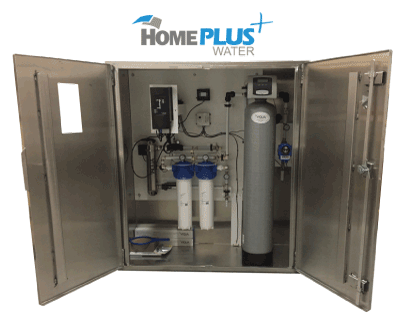What Does a Typical POE System Consist of?
Certified Water Technician
HomePlus Products Inc.
www.homepluswater.com
The first cartridge filter is designed to reduce sediment particles and other physical debris in the water (generally either 5 micron or 1 micron nominal). The second cartridge filter provides filtration to an even finer level (most often to a level of 1 micron absolute). At this level, many waterborne pathogens such as cryptosporidium and giardia that are commonly found in surface water sources, are removed. These filters meet or exceed the minimum pre-treatment requirements for the UV sterilizer which is responsible for disinfecting the water to address bacteria, viruses, and other microbiological contaminants.
The ancillary treatment equipment most often includes such things as an emergency solenoid shut-off valve, sample ports, pressure gauges for monitoring filter clogging, a surge protector/back-up power supply, and leak detection devices.

Depending on the contaminants present in the source water, additional treatment may be required to ensure effective operation, to meet the requirements of the Act and Regulations, and to reduce operating costs and maintenance requirements. Additional treatment is generally required when any of the following conditions are present:
- Turbidity frequently exceeds 3 NTU;
- Hardness exceeds 120 mg/l (7 grains per gallon);
- Iron exceeds 0.3 mg/l (ppm);
- Manganese exceeds 0.05 mg/l (ppm);
- Total Organic Carbon (TOC) is greater than 3 mg/l (ppm) and/or UV Transmittance is less than 80%; or
- Any other contaminant, other than bacteria indicators, exceeds Health Canada guidelines.
It should be strongly emphasized that not all water treatment equipment is acceptable by the regional health authorities in the province. There are specific third-party performance and material safety validation requirements that must be met in order for equipment to be approved for use by the relevant Public Health Engineer at the regional health authority responsible for your system. For instance, the majority of UV sterilizers on the market, do not meet these validation requirements and thus cannot be used. When POE is being contemplated, community members often step forward to indicate that they have already installed their own treatment systems - they should be cautioned that their existing equipment might not meet the health authority requirements.




